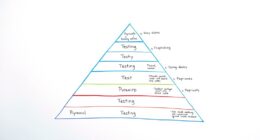Embracing Kaizen in software development means making small, consistent improvements that lead to big wins over time. Focus on tiny changes like expanding automated tests, streamlining deployment, and refining processes daily. These incremental steps create a culture of continuous quality enhancement, boosting reliability and reducing errors. By staying committed to manageable progress, you’ll see faster delivery and higher software standards. Keep exploring how these small actions can transform your development journey for lasting success.
Key Takeaways
- Implement small, continuous improvements through automation and testing to steadily enhance software quality.
- Use automated testing to quickly identify bugs, reducing manual effort and preventing regressions.
- Adopt incremental deployment strategies to deliver regular updates and gather user feedback efficiently.
- Cultivate a culture of daily, manageable changes that build momentum toward significant long-term gains.
- Maintain team motivation and resilience by celebrating small wins and fostering a mindset of ongoing refinement.

Have you ever wondered how continuous improvement can elevate your software quality? The answer lies in embracing the principles of Kaizen—making small, consistent changes that add up to significant enhancements over time. In the fast-paced world of software development, this approach can transform your processes, reduce errors, and boost reliability. One way to foster this mindset is by integrating automated testing into your workflow. Automated testing allows you to quickly identify bugs and regressions, giving you immediate feedback on changes you make. Rather than waiting for manual testing cycles, automation helps you catch issues early, saving time and reducing the risk of releasing flawed code. This continuous feedback loop encourages small improvements with each iteration, aligning perfectly with the Kaizen philosophy. By constantly refining your test cases and expanding your test coverage, you create a culture of quality that becomes second nature to your team.
Embrace automated testing to catch bugs early and foster a culture of continuous improvement.
Another critical aspect of applying Kaizen is adopting continuous deployment. This practice enables you to deploy small, incremental updates regularly rather than large, infrequent releases. Continuous deployment fosters a mindset of ongoing improvement because it compels you to streamline your development and release processes. When you deploy often, you can quickly observe the impact of your changes, gather user feedback, and make adjustments without delay. This iterative approach minimizes risks associated with big releases and encourages your team to focus on refining the development pipeline itself—automating builds, tests, and deployments so that each step is efficient and reliable. Over time, these small, manageable deployments lead to higher software quality, as issues are caught and resolved faster, and the software evolves through continuous, measurable improvements.
The secret to making this work is consistency. Kaizen isn’t about drastic overhauls but about committing to small, manageable steps every day. You might start by automating a few repetitive tests, then gradually expand coverage, or by setting up a continuous deployment pipeline that reduces manual intervention. As these small improvements become routine, they create a ripple effect—enhancing your development speed, reducing bugs, and improving overall software stability. Incorporating practices rooted in Yoga’s emphasis on mindfulness can help your team stay focused and balanced during this process, fostering resilience and sustained effort. The cumulative effect of these incremental changes is often more sustainable and less disruptive than large-scale, sweeping changes. Plus, it keeps your team motivated, as each small win provides a sense of progress and achievement.
Ultimately, integrating automated testing and continuous deployment into your development cycle embodies the essence of Kaizen. It’s about fostering a mindset where continuous, small improvements are part of your daily routine. Over time, this disciplined approach leads to higher quality software, faster delivery times, and a more engaged, proactive team. Small steps might seem insignificant on their own, but when combined, they produce big wins for your software projects.
Frequently Asked Questions
How Can Kaizen Be Integrated Into Existing Software Development Workflows?
You can integrate Kaizen into your existing software development workflows by focusing on process integration and fostering a cultural shift towards continuous improvement. Encourage your team to regularly review and refine procedures, emphasizing small, incremental changes. Promote open communication and collaborative problem-solving, making Kaizen a natural part of daily routines. This approach helps build a culture of ongoing enhancement, ultimately leading to higher quality and more efficient software development.
What Tools Best Support Continuous Improvement in Software Quality?
You should focus on automation tools like CI/CD pipelines, static code analyzers, and issue tracking systems to support continuous improvement in software quality. These tools streamline processes and reduce errors, allowing you to implement quick feedback loops. Regularly gathering feedback from users and team members helps you identify areas for enhancement, ensuring your software evolves efficiently. Combining automation with feedback loops creates an effective environment for ongoing quality improvements.
How Do Teams Measure Success When Applying Kaizen Principles?
Imagine you’re steering a ship through calm waters; success is when your crew is synchronized and the journey smooth. You measure this with performance metrics like defect rates or cycle times, and observe team engagement to make certain everyone’s rowing in harmony. These indicators show how well your continuous improvement efforts are sinking in, guiding you toward better quality and stronger teamwork. Success is a steady course, driven by small, meaningful adjustments.
Can Kaizen Practices Be Adapted for Remote or Distributed Teams?
You can adapt kaizen practices for remote teams by leveraging virtual collaboration tools. Encourage asynchronous feedback, allowing team members to review and suggest improvements at their convenience. Use regular virtual check-ins to track progress and celebrate small wins. This approach promotes continuous improvement, keeps everyone engaged, and maintains the kaizen mindset, even across different locations. Emphasizing open communication and incremental changes helps remote teams thrive.
What Common Pitfalls Should Teams Avoid When Implementing Kaizen for Quality?
Did you know 70% of change initiatives fail due to resistance or complacency? When implementing kaizen, you should avoid common pitfalls like underestimating resistance to change and overconfidence in current processes. Teams often fall into complacency, thinking small improvements aren’t enough. Stay vigilant, encourage open feedback, and address resistance early. This way, you maintain momentum and guarantee continuous progress toward quality improvements.
Conclusion
So, next time you’re tempted to ignore that tiny bug or skip a code review, remember: kaizen’s all about those small steps. Who knew that tiny tweaks could lead to giant leaps in software quality? Keep chipping away, celebrate small wins, and watch your code improve faster than you can say “big wins.” After all, in the world of software, it’s the little things that turn chaos into clarity—one tiny step at a time.
Randy serves as our Software Quality Assurance Expert, bringing to the table a rich tapestry of industry experiences gathered over 15 years with various renowned tech companies. His deep understanding of the intricate aspects and the evolving challenges in SQA is unparalleled. At EarnQA, Randy’s contributions extend well beyond developing courses; he is a mentor to students and a leader of webinars, sharing valuable insights and hands-on experiences that greatly enhance our educational programs.










